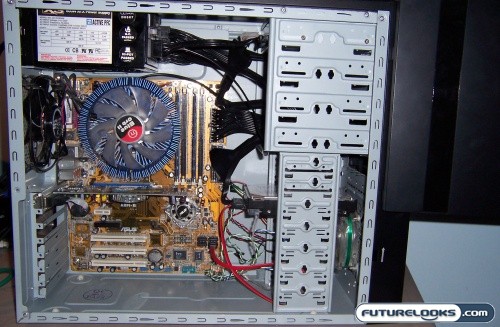Let’s give this case some guts!
We’ve rounded up the following components to be assembled into this case:
- AMD Athlon 64 3800+ Socket 939 CPU
- Asus A8N-E Motherboard
- MGE 500 Watt PSU
- 2 x Transcend 512 DDR PC-3200 Memory Modules
- BFG Geforce 7300 GS Video Card
- Maxtor Maxline Pro 500, 500 GB
We’ve also decided to put in a 120mm artic cooling fan in for the rear exhaust and a 80mm fan in for the front fan. The reasoning for this was simple: The huge side fan moves quite a bit air, but blows it in directly against the motherboard. Without a equally beefy fan on the back end sucking almost as much air out, it would be hard to ensure good airflow in the case itself.
Installation
The setup and installation of this case was very straightforward. All you need is a Phillips screwdriver, your motherboard manual and about twenty minutes of your time. Overall, the case is nice to work with , feeling nice and sturdy – – something to expect from a quality build. Let’s see what this thing looks like with some guts!

With some components and large side fan, this case does indeed look fearsome. Overall, it has a lot of space to work with and leaves quite a bit of room for expansion. But how well does that side fan actually work?
Test Setup
There are overall two things that we want to test with this case: It’s noise level and it’s temperature rating. Since we want to test the noise level of just the large fan and not the rest of the setup, we hooked up a power supply just to the side fan and closed the case up to take our noise readings.
For temperature ratings, the computer is started from a cold-boot into a Windows XP Pro SP2 install at room temperature (22 degrees Celsius here) and is then subjected to 30 minutes of a 2 x CPU-Burn in to get the CPU nice and toasty. We then allow the CPU to idle for thirty minutes to get it’s running idle temperature. To monitor temperature levels, we used AMD64 CPU Assistant.
After we’ve recorded the running idle of the machine, we start two instances of CPU-Burn in and run the machine for an hour. After that hour is up, we continue to run the machine under load until we can pinpoint a stable maximum CPU temperature and record it. So, what did we find?
Noise levels
If there is one thing I cannot stand, it’s a noisy case. With the large fan on this case I was expecting quite a bit of noise, however I found quite the contrary. The 360mm fan itself only seems to carry about 20 dBA of noise, which is quite respectable for it’s size and the amount of air it moves. The overall case produces just shy of 50 dBA of noise and how much noise the cases produces overall will highly depend on the components to choose. The side fan does not add too much noise, and it is not too noticeable even when it is running at full RPM’s.
Temperature Levels
So the noise levels don’t seem to be much of a problem here. But how does that big honking fan cool? Let’s see what the temperatures say…
Temperature levels in open Air:
| Idle | Loaded | |
| CPU | 29 | 40 |
| GPU | 54 | 69 |
| PWM | 33 | 43 |
Temperature Levels in Xclio at full fan power:
| Idle | Loaded | |
| CPU | 28 | 39 |
| GPU | 52 | 68 |
| PWM | 31 | 42 |
I ran the tests multiple times and found that the results were indeed consistent. Unfortunately we are not as impressed with the temperature levels in the case as we had hoped to be, since it is sporting a 360mm fan. I believe what may be happening is that air flow is impeded by the graphics/PCI cards causing the air to not move around as freely as it should. A case with a different card layout may fare better on these tests. That being said, I can’t complain too much as the fan is quite quiet and it did take a couple of degrees off here and there!
Real-Time Price and Stock Check
